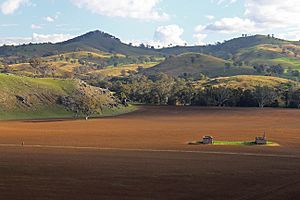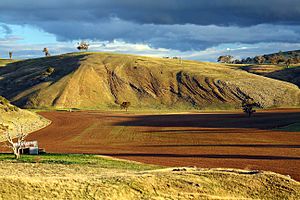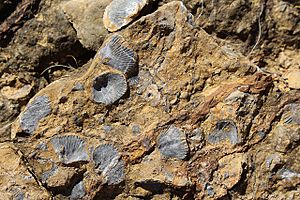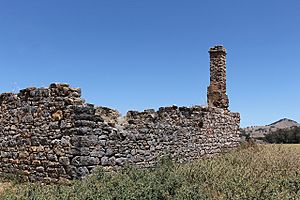Cliefden Caves facts for kids
Quick facts for kids Cliefden Caves |
|
|---|---|
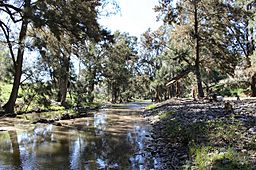
Natural and cultural landscape, Belubula River
|
|
| Location | Mandurama, New South Wales, Australia |
| Discovery | 1815 – George Evans |
| Geology | Limestone |
| Managing authorities | |
|---|---|
| Official name: Cliefden Caves Area | |
| Designated: | 11 August 1987 |
| Reference #: | 000958 |
| Official name: Cliefden Caves Area | |
| Designated: | 30 August 1987 |
| Reference #: | 01996 |
The Cliefden Caves are a very special place in Mandurama, Australia. It's known for its ancient limestone caves, a natural spring, and unique rock formations. This area is also famous for its incredibly old fossils.
Experts say Cliefden Caves is one of Australia's most important fossil sites. It's also ranked as one of the top limestone cave sites. Because it's so special, it was added to the New South Wales State Heritage Register in 2017. This means it's protected for future generations.
A Look at Cliefden Caves
Ancient History of the Area
Aboriginal People and the Land
The Wiradjuri language group has lived in the Cliefden Caves area for a very long time. They have been here for at least 6,000 years, possibly even 30,000 years! You can still find signs of their camps and special scarred trees nearby. The caves were important places for them.
European Discovery and Early Days
In 1815, a surveyor named George Evans was exploring the area. He was the first European to discover the limestone here. This was just two years after the Blue Mountains were crossed.
By 1832, maps already showed caves like "Bushrangers Cave" and "Immense Cave." The first land grants were given to the Rothery brothers in 1832. Their old barn still has bullet holes from when Ben Hall's gang held them up in the 1860s!
Protecting the Caves
In 1908, cave experts Oliver Trickett and J. C. Wiburd visited the caves. They were worried because visitors were damaging the beautiful cave formations. They said the "Main Cave" was definitely "well worth preserving."
Later, in the 1930s, the Australian Museum collected thousands of cave formations. They used these to create a special cave exhibit at the museum.
In the 1950s, scientists discovered that the limestone here was from the Ordovician period. This means it's incredibly old, dating back hundreds of millions of years! Geologists worldwide think it's an amazing example of an ancient island environment.
As the caves became more popular, the Main Cave was gated in 1958. The Orange Speleological Society (OSS) now helps manage access. They work to protect the caves and advise the landowners.
What Makes Cliefden Caves Special?
Amazing Fossils
The Cliefden Caves area is packed with fossils! It's one of the best places in Australia to find fossils from the Late Ordovician period. Imagine finding some of the earliest shell beds and corals ever known! More than 180 different species have been found here.
This area shows how life changed from shallow ocean waters to deep-sea environments. Many of the fossils, like the Belubula spectacula brachiopod, are found nowhere else in the world. This helps scientists understand how continents moved long ago.
The Caves Themselves
Cliefden Caves has over 100 recorded caves, making it one of the most cave-filled areas in New South Wales. Some of the bigger caves include Main Cave, Murder, Boonderoo, and Taplow Maze.
Inside, you'll find amazing cave formations called speleothems. These include helictites (which grow in strange directions), large crystals, and even rare blue formations! You can also see common ones like stalagmites and stalactites. The colours range from clear to white, yellow, orange, and even sky blue or aqua green.
To protect these delicate formations, most major caves are locked. However, scientists and cave explorers can get special permits to study them.
Unique Natural Features
The area also has special features above ground. There's a warm, natural spring, which is rare in New South Wales. Studies of the tufa deposits (a type of limestone) in Davys Creek help us understand past climate changes.
Cliefden Caves is also a hotspot for microbats! There are 15 confirmed species living here. One cave is a winter home for the Eastern Bentwing Bat, and another is a maternity cave for the Common Horseshoe Bat.
Historical Structures
You can also find old buildings and sites linked to the area's past. These include Rothery's Ruins and the Old Barite Mine. They tell us about the early European settlement and mining history.
Threats to the Caves
Unfortunately, the Cliefden Caves face a big threat. There are plans to build a dam on the Belubula River at a place called The Needles. This dam would flood most of the known caves, the thermal spring, and many of the important fossil sites. This would destroy their heritage value and stop future studies.
The NSW Government gave the area heritage protection in 2017. This helps highlight how important it is to protect this unique place.
Why Cliefden Caves is Important
Cliefden Caves is important for many reasons:
- Natural History: It helps us understand the geological history of New South Wales. The rocks show how a volcanic island formed and changed millions of years ago.
- Fossil Riches: It has the best examples of Late Ordovician marine fossils in Australia. Many species found here are unique to the area.
- Cave System: It's one of the most cave-filled limestone areas in NSW. The caves have many different types of beautiful and rare formations.
- Cultural Value: It's very important to the Wiradjuri traditional owners. They consider it a sacred place and continue to visit for cultural practices.
- Scientific Research: Scientists are still studying the fossils, caves, climate, and archaeology here. It's a great place to learn about NSW's natural history.
- Rare Features: The thermal spring and active tufa dams are uncommon in NSW. The blue cave formations are also extremely rare.
This amazing place helps us understand our past, from ancient life to human history. It's a truly special part of Australia's heritage.


